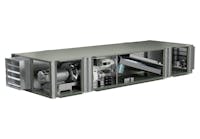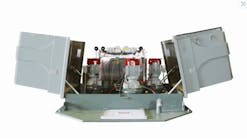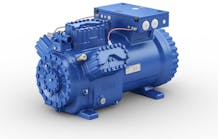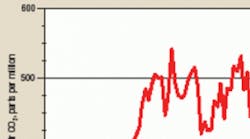Long known to correlate with human metabolic activity, carbon-dioxide (CO2) levels are a reliable indicator of indoor pollution originating from building occupants. Demand-controlled ventilation (DCV), the process by which outside air is varied based on the amount of CO2 in a space, has been around for 15 to 20 years. Yet despite the energy-saving and health benefits of providing just the right amount of outside air needed by building occupants, DCV is underutilized because of concerns about non-human indoor pollutants,1 as well as issues surrounding control accuracy, sensor calibration, and maintenance. This article explains how a centralized facility-monitoring system capable of sensing multiple points and both human and non-human pollutants — multi-parameter demand-controlled ventilation (Mp DCV) — resolves all of those perceived limitations.
SENSOR PLACEMENT
With a conventional DCV system, discrete CO2 sensors are installed in the spaces to be controlled. These sensors generally report to a building-management system (BMS) or, in the absence of a BMS, directly control outside-air dampers or variable-air-volume boxes. Because ANSI/ASHRAE Standard 62.1, Ventilation for Acceptable Indoor Air Quality, is concerned with the difference between indoor and outdoor, rather than absolute, CO2 levels, sensors for outside air also must be provided. (As Figure 1 shows, outside-air CO2 levels can vary greatly over a 24-hr period.)
Mp DCV replaces as many as 30-plus discrete sensors in individual spaces with a single centrally located sensor. Air samples are transported from an outside-air sampling point and each space being monitored to the centrally located sensor, most commonly through the use of small-bore flexible conduit (microduct), with the sequencing of the samples controlled by electronically operated solenoid valves.
With a typical air sample having a volume of approximately 0.5 cu ft and a velocity of 20 fps, microduct must be highly conductive to prevent the buildup of electrostatic charge on particles in the air. It also must be extremely inert to prevent sorption or desorption of sample constituents.
Because the number of sensors is reduced greatly, compliance with the American Society of Heating, Refrigerating and Air-Conditioning Engineers-recommended calibration frequency of every six months is much less costly with Mp DCV than it is with conventional DCV.
SENSOR ACCURACY
Most commercial- and laboratory-grade CO2 sensors are based on non-dispersive-infrared (NDIR) technology — that is, an infrared (IR) light source and an IR detector. As with any light source, accuracy varies, and devices fail. With Mp DCV, the number of devices to be replaced is reduced greatly, resulting in significant cost savings and fewer disruptions of operations.
The tendency of NDIR sensors to drift gives rise to concerns about control inaccuracy. Most sensors have accuracies of ±75 ppm. If an outside-air sensor and a single inside space sensor were to drift the same amount in the same direction, the errors would cancel, and the desired CO2 differential would be maintained. The worst-case scenario for sensor error translating to ventilation error would be for both sensors to drift the maximum amount in different directions. Figure 2 shows CO2 ranging from 375 to 675 ppm. In the former case, the space is significantly underventilated because CO2 is thought to be 150 ppm below the desired threshold; in the latter case, the space is overventilated because CO2 is thought to be 150 ppm above. That is a +29-percent error, which translates to approximately 6 cfm of unnecessary ventilation.
To the owner of a building with 500 full-time-equivalent occupants paying 10 cents per kilowatt-hour for electricity and $5 per cubic foot per minute per year for conditioned outside air, the cost in wasted energy is $15,000 annually. Although this is a simplistic — and somewhat conservative — example, it indicates the magnitude of the savings that can result from improved ventilation. The environmental impact is approximately 92 metric tons of CO2, which, according to the U.S. Environmental Protection Agency's (EPA's) Emissions and Generation Resource Integrated Database (eGRID) (www.epa.gov/cleanenergy/energy-resources/egrid/index.html), is the equivalent of 18 average automobiles burning nearly 11,185 gal. of gasoline.
In 2006, Lawrence Berkeley National Laboratory undertook a pilot study of commercial buildings in which CO2 sensors were installed.2 Although the relatively small sample size (nine buildings) provided only an initial indication of the in-situ performance of the sensors, the study indicated a need for more accurate CO2 sensors and validated the need for better maintenance and calibration.
Because a Mp DCV system uses the same sensor for outside-air and inside-space measurements, any error is offset, just as in the case of two sensors that drift the same amount in the same direction.
NON-HUMAN POLLUTANTS
The issue of non-human indoor pollutants is addressed with additional discrete sensors in the central sensor array. Typically, non-human pollutants to be addressed in a commercial building include carbon monoxide (CO), volatile organic compounds (VOCs), and respiratory-size (less-than-2.5-µm diameter) particles.
CO in concentrations above 35 ppm can produce symptoms in humans. The Occupational Safety and Health Administration-permissible exposure limit for CO is 50 ppm.3 At least 19 states have a code requirement governing CO detection, particularly in residential structures.
VOCs are emitted from a variety of chemicals (both methane and non-methane hydrocarbons) and can be significantly higher indoors than outdoors. Common VOC-emitting products include paints and lacquers; paint strippers; cleaning supplies; pesticides; building materials and furnishings; office equipment, such as copiers and printers; correction fluids and carbon-less copy paper; graphics and craft materials, including glues and adhesives; permanent markers; photographic solutions; and stored fuels and automotive products.
According to the EPA, the health effects of exposure to VOCs include eye, nose, and throat irritation; headaches; loss of coordination; nausea; and liver, kidney, and central-nervous-system damage. Some VOCs can cause cancer in animals, and some are suspected or known to cause cancer in humans.4 Additionally, methane is a significant environmental hazard, with a global-warming potential of 25 averaged over 100 years, compared with a base value of 1 for CO2.5
Constituents of fine-particle aerosols that are too small to be filtered by the nose and, thus, are inhaled directly into the lungs, respirable-fraction particles with diameters of less than 2.5 µm (PM2.5) are a significant contributor to nosocomial infections.6 Once a virus suspended on PM2.5 particles contaminates an air space, the degree of infection transmission is limited only by the survival of the virus and the ventilation in the space.
Small-particle aerosols also are a major factor in cross-contamination of cleanrooms and laboratories.
Other benefits of a Mp DCV system with PM2.5 monitoring include the ability to detect filter breakthrough. In applications using costly to maintain high-efficiency-particulate-air and/or high-minimum-efficiency-reporting-value filters, such as hospital surgical suites and cleanrooms, filter changes can be based on differential pressure and PM2.5 counts, rather than an arbitrary schedule. And because it is monitored for the same non-human pollutants, outside air that is of significantly poorer quality than indoor air can be kept out. Also, comfort control can be enhanced, as a dew-point sensor can be added to the central sensor array and, along with the local thermostat, provide an extremely accurate relative-humidity value to be used in controlling the latent load.
SUMMARY
Although conventional CO2-driven DCV offers an opportunity for energy-cost savings and carbon-footprint reduction, it never has realized its full potential because of concerns involving non-human pollutants, control accuracy, and calibration and maintenance. Mp DCV satisfactorily addresses all of those issues by providing highly accurate differential sensing of multiple points and pollutants with a significantly reduced number of sensors, providing greater indoor-air quality and energy efficiency.
-
REFERENCES
Roth, K.W., Dieckmann, J., & Brodrick, J. (2003, July). Emerging technologies: Demand control ventilation. ASHRAE Journal, pp. 91-92.
-
Fisk, W.J., Faulkner, D., & Sullivan, D.P. (2006). Accuracy of CO2 sensors in commercial buildings: A pilot study. Berkeley, CA: Lawrence Berkeley National Laboratory. Retrieved from http://repositories.cdlib.org/lbnl/LBNL-61862/
-
OFR. (2006). Code of federal regulations (29 CFR table Z-1). Washington, DC: Office of the Federal Register.
-
EPA. (2009). An introduction to indoor air quality: Organic gases (volatile organic compounds - VOCs). Washington, DC: Environmental Protection Agency. Retrieved from http://www.epa.gov/iaq/voc.html
-
IPCC. (2007). Summary for policymakers. Cambridge, UK, and New York: Cambridge University Press. Retrieved from http://ipcc-wg1.ucar.edu/wg1/Report/AR4WG1_Print_SPM.pdf
-
Mayhall, C.G. (2004). Hospital epidemiology and infection control (3rd ed.). Philadelphia: Lippincott Williams & Wilkins.
For past HPAC Engineering feature articles, visit www.hpac.com.
Larry Clark, LEED AP, is director of corporate business development for Hill York, an award-winning air-conditioning commercial contractor specializing in high-rise complexes. He can be contacted at [email protected].









